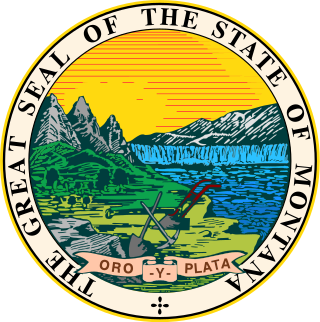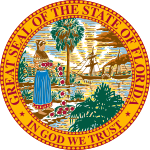
The 82nd United States Congress was a meeting of the legislative branch of the United States federal government, composed of the United States Senate and the United States House of Representatives. It met in Washington, D.C., from January 3, 1951, to January 3, 1953, during the last two years of President Harry S. Truman's second term in office.

The 1952 United States Senate elections was an election for the United States Senate which coincided with the election of Dwight D. Eisenhower to the presidency by a large margin. The 32 Senate seats of Class 1 were contested in regular elections, and three special elections were held to fill vacancies. The Republicans took control of the Senate by managing to make a net gain of two seats. However, Wayne Morse (R-OR) became an independent forcing Republicans to rely on Vice President Richard Nixon's tie-breaking vote, although Republicans maintained a 48–47–1 plurality. Throughout the next Congress, Republicans were able to restore their 49–46–1 majority. This was the third time, as well as second consecutive, in which a sitting Senate leader lost his seat.

The 1952 United States Senate election in North Dakota took place on November 4, 1952, to elect a member of the United States Senate to represent the State of North Dakota, concurrently with other Class 1 elections to the Senate and various other federal, state, and local elections.

The 1952 Maine gubernatorial election took place on September 8, 1952. Incumbent Republican Governor Frederick G. Payne was term limited and seeking election to the United States Senate, thus did not run. Maine Senate President Burton M. Cross faced off against Democratic challenger, former Congressman James C. Oliver and Independent Neil Bishop in the general election, easily defeating both men. Burton's election was the ninth consecutive victory for the Republicans in Maine gubernatorial races.

The 1952 United States elections were held on November 4, 1952, during the Cold War and the Korean War. General of the Army Dwight D. Eisenhower won the White House in a landslide over Democratic governor Adlai Stevenson of Illinois. Meanwhile, Republicans narrowly took control of both chambers of Congress, giving Republicans their first trifecta since the Great Depression. This is the last election until 2000 in which the Republicans held both chambers of Congress and the presidency at the same time. For the rest of the century, Republicans would often still win the presidency without full control of Congress.

Montana became a territory May 28, 1864 and the first delegation created nine counties: Beaverhead, Big Horn, Chouteau, Deer Lodge, Gallatin, Jefferson, Edgerton, Madison, and Missoula. Montana became a state on November 8, 1889.

The 1952 United States Senate election in Maryland was held on November 4, 1952.

The 1952 United States Senate election in Montana took place on November 4, 1952. Incumbent United States Senator Zales Ecton, who was first elected to the Senate in 1946, ran for re-election. Ecton won the Republican primary uncontested, and advanced to the general election, where he faced Mike Mansfield, the United States Congressman from Montana's 1st congressional district and the Democratic nominee. Following a close campaign, Mansfield narrowly defeated Ecton, winning his first of several terms in the Senate.

The 1952 United States Senate election in Vermont took place on November 4, 1952. Incumbent Republican Ralph Flanders successfully ran for re-election to another term in the United States Senate, defeating Democratic candidate Allan R. Johnston.

The 1952 United States Senate election in Maine was held on September 8, 1952.

The United States Senate election in Washington of 1952 was held on November 4, 1952. Incumbent and highly-controversial Republican Harry Cain ran for a second term in office, but was defeated by Democratic U.S. Representative Henry M. Jackson. Jackson would come to serve 30 years as a United States Senator, and this would be his only election to the Senate in which he lost any of the state’s counties.

The 1952 United States Senate election in Minnesota took place on November 4, 1952. Incumbent Republican Edward John Thye defeated Democratic challenger Bill Carlson to win a second term.

The 1952 United States Senate election in Michigan was held on November 4, 1952 alongside a special election to the same seat.

The 1952 United States Senate election in Delaware took place on November 4, 1952. Incumbent Republican U.S. Senator John J. Williams was re-elected to a second term in office over Democratic Lieutenant Governor Alexis I. du Pont Bayard, the son of former Senator Thomas F. Bayard, Jr. and descendant of two of Delaware's most powerful families, the du Ponts and the Bayards.

The 1952 United States Senate election in California was held on November 4, 1952, concurrently with the 1952 U.S. presidential election as well as other elections to the United States Senate and House of Representatives and various state and local elections.

The 1952 United States Senate special election in Kentucky was held on November 4, 1952, to complete the unexpired term of the late Senator Virgil Chapman. Interim Senator Thomas R. Underwood ran to complete the term but was defeated by Republican former Senator John Sherman Cooper.

The 1952 United States Senate special election in Connecticut was held on November 4, 1952, to fill the vacancy left by the death of Brien McMahon.

The 1954 United States Senate election in Kentucky took place on November 2, 1954. Incumbent Republican Senator John Sherman Cooper, who won a 1952 special election to fill the vacant seat of Virgil Chapman, ran for a full term in office but was defeated by Democratic former Senator and Vice President of the United States Alben Barkley.

The 1952 Iowa State Senate elections took place as part of the biennial 1952 United States elections. Iowa voters elected state senators in 30 of the state senate's 50 districts. State senators serve four-year terms in the Iowa State Senate.




















